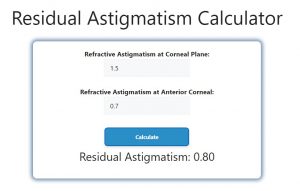About Residual Astigmatism Calculator (Formula)
Residual astigmatism is a condition that occurs when there is a difference in the refractive power of the eye, even after corrective procedures such as LASIK or cataract surgery. It reflects the remaining astigmatism that has not been corrected by surgery or other refractive techniques. Understanding residual astigmatism is crucial for optimizing visual outcomes and ensuring that patients achieve the best possible vision. The Residual Astigmatism Calculator helps eye care professionals assess this condition accurately, allowing them to make informed decisions regarding additional corrective measures.
Formula
The formula for calculating Residual Astigmatism (RA) is:
Residual Astigmatism (RA) = Refractive Astigmatism at Corneal Plane (RACP) – Refractive Astigmatism at Anterior Corneal (RAAC)
Where:
- Refractive Astigmatism at Corneal Plane (RACP) refers to the total astigmatism measured at the corneal surface.
- Refractive Astigmatism at Anterior Corneal (RAAC) refers to the astigmatism measured at the anterior surface of the cornea.
How to Use
Using the Residual Astigmatism Calculator involves a few straightforward steps:
- Gather Measurements: Obtain the refractive astigmatism values at both the corneal plane and the anterior corneal surface from the patient’s eye examination.
- Input Values: Enter the RACP and RAAC values into the calculator.
- Calculate RA: Click the calculate button to determine the Residual Astigmatism.
Example
To demonstrate the use of the Residual Astigmatism Calculator, consider the following example:
- Input Values:
- RACP = 1.5 D (diopters)
- RAAC = 0.7 D (diopters)
- Apply the Formula:
- Residual Astigmatism (RA) = 1.5 D – 0.7 D
- Residual Astigmatism (RA) = 0.8 D
In this example, the Residual Astigmatism is 0.8 D, indicating that this amount of astigmatism remains uncorrected.

FAQs
- What is Residual Astigmatism?
Residual astigmatism is the astigmatism that remains after surgical correction, affecting visual acuity. - Why is it important to measure Residual Astigmatism?
Measuring residual astigmatism is crucial for determining the effectiveness of surgical procedures and planning any additional corrections. - How is Residual Astigmatism calculated?
It is calculated by subtracting the refractive astigmatism at the anterior corneal surface from the refractive astigmatism at the corneal plane. - What values do I need to calculate Residual Astigmatism?
You need the refractive astigmatism values at both the corneal plane and the anterior corneal surface. - Can Residual Astigmatism affect vision quality?
Yes, it can lead to blurred or distorted vision, impacting overall visual quality. - What treatments are available for Residual Astigmatism?
Treatment options may include corrective lenses, further refractive surgery, or toric contact lenses. - Is it common to have Residual Astigmatism after surgery?
Yes, some degree of residual astigmatism can occur after various refractive surgeries. - Can lifestyle factors influence Residual Astigmatism?
While lifestyle factors primarily affect overall eye health, they can indirectly impact visual outcomes. - What is the difference between regular and residual astigmatism?
Regular astigmatism is the initial condition, while residual astigmatism refers to the remaining astigmatism after treatment. - How often should Residual Astigmatism be assessed?
It should be assessed during regular eye examinations, especially after refractive surgery. - Does Residual Astigmatism change over time?
Yes, it can change due to natural eye changes or additional surgical interventions. - What is the significance of diopter measurements?
Diopter measurements quantify the degree of refractive error, including astigmatism. - How does the Residual Astigmatism Calculator work?
It uses input values to apply the formula, providing a quick and accurate assessment. - Can I use the calculator for both eyes?
Yes, you can use it to calculate residual astigmatism for each eye separately. - What is the best way to prevent Residual Astigmatism?
Choosing an experienced surgeon and appropriate surgical technique can help minimize the risk. - Are there any side effects of having Residual Astigmatism?
It may cause visual disturbances, but it can usually be corrected. - How does residual astigmatism relate to overall eye health?
It is a specific measure of refractive error and does not directly relate to other eye health issues. - Can regular eye exams detect Residual Astigmatism?
Yes, comprehensive eye exams can identify residual astigmatism. - What happens if Residual Astigmatism is left untreated?
Uncorrected residual astigmatism may lead to discomfort and suboptimal vision. - Is there a specific range for acceptable Residual Astigmatism?
Acceptable levels can vary based on individual patient needs and clinical standards.
Conclusion
The Residual Astigmatism Calculator is an essential tool for eye care professionals, providing a straightforward way to assess the remaining astigmatism after surgical procedures. By understanding and measuring residual astigmatism, practitioners can make informed decisions about potential treatments and improve their patients’ visual outcomes. Regular assessments of residual astigmatism contribute to better eye health management and ensure that individuals achieve optimal vision post-surgery.